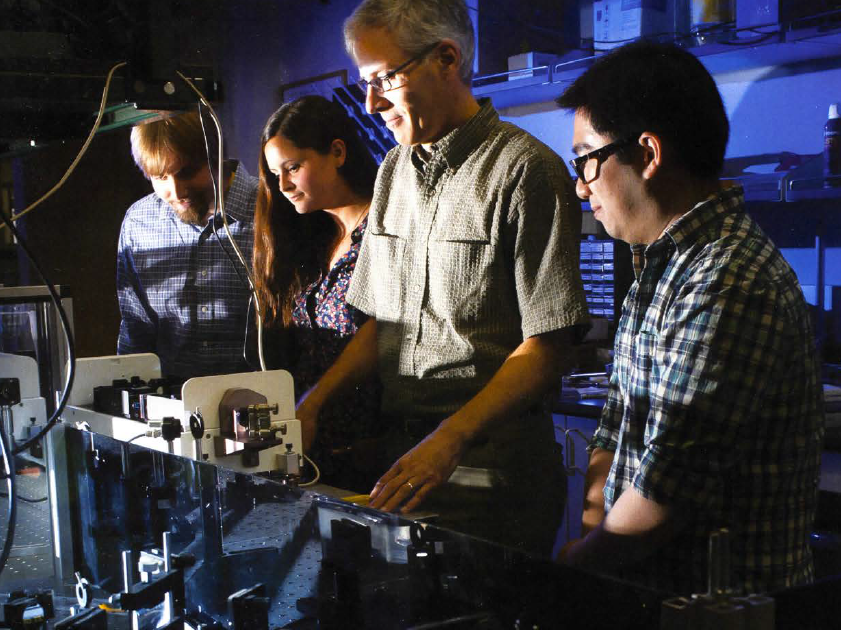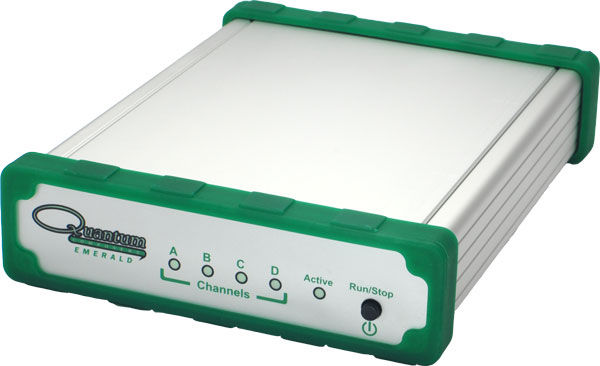Share this
Student Researchers Aim at Developing Low-Cost, Portable LiDAR System
June 4, 2021

Photo of: Past MSU Students in Lasers and Optics Research
Last year, a group of Montana State University students stumbled upon the need for a portable, low-cost LiDAR system for educational purposes. The Optical Remote Sensor Laboratory (ORSL) at MSU seeks to educate others on imaging technologies in applications such as precision agriculture and climate science. This innovative student research team worked together to develop an affordable, portable LiDAR rangefinder and the accompanying educational package for teaching LIDAR to future generations of learners.
A Capstone Project
The student's paper outlines that their design uses a “pulsed diode laser at 635 nm wavelength an optical receiver with a 2.5 cm diameter lens, interference filter, and photodiode. The detector signal is passed into a comparator, whose output is used to determine range with a time-to-digital converter chip and processed with a microcontroller. Range data is then displayed in a GUI on a laptop screen. The system was designed to detect the location of solid objects at ranges up to 10 m. The main source of cost reduction within the system is achieved by using a fully integrated time-of-flight chip as well as small low-cost optics.” The team employed a Quantum Composers Emerald 9250 digital delay pulse generator as their synchronizer, as it was able to provide multiple independent channels, 5ps timing resolution, and a high level of accuracy as compared to similar units.
Role of the Digital Delay Pulse Generator
The Emerald pulse generator was used to provide square wave signals to precisely coordinate the system device’s timing and display. With its four independent outputs, the Emerald generated multiple waveforms with a time delay between channels and a 5 ps resolution. Resolution and accuracy of the width, delays, and period counters allowed for 10 kHz square waves with an amplitude of 3.30 Vpp and offset of 1.65 V. They noted that “Three different ToFs were simulated with 5 measurements performed on each. The ToFs tested were 33.36 ns (10 m), 16.68 ns (5 m), 0.665 ns (20 cm).” Ranges were calculated in MATLAB and showed that the TDC/MCU combo could measure the minimum and maximum ranges required and those in-between with an absolute maximum offset of 1.5 cm, which met the specifications.
Conducting Research in a Pandemic
While the original project goal was to build a fully operational portable LiDAR rangefinder, COVID-19 impacted lab space and equipment availability, requiring the team to pivot by working remotely using whatever they had in terms of resources and equipment while social distancing. In the end, the students successfully identified, tested, documented subsystems, hardware, code, and documentation—all within budget—for the next set of researchers who are on track to complete the device this year.
These Montana State University students were able to meet challenges as well as excel in the face of unforeseen challenges in the integration, testing, and verification work on this complicated technology amid unusual circumstances. They in addition to the Montana State University staff serve as an outstanding example of the kind of ingenuity and perseverance that came from the COVID-19 challenges of the past year
About the Quantum Composers Pulse Delay Generator

Quantum Composers understands that researchers may have a variety of applications and projects and created a whole line of pulse generators to match the varied needs and budgets. The Emerald 9250 comes standard with a 280 ppb TCXO oscillator, giving the user a higher performance without extra cost.
Quick Specs
Channels: 4 Independent Channel Outputs
Resolution: 5ps
Accuracy: 1 ns + (0.0001 x delay)
Jitter: 15 ps + (1e-8 x delay)
Memory: 6 Storage Slots
Comm Ports: USB, Bluetooth (Optional)
Resources
Share this
- photonics (20)
- Lasers (12)
- DPSS Lasers (11)
- pulse delay generator (8)
- pulse generator (8)
- LIDAR (4)
- Laboratory Science (4)
- Lasers and Optics (4)
- PIV (4)
- Technology (4)
- LIBS (3)
- Laser Research (3)
- Nd:YAG Lasers (3)
- Science (3)
- Spectroscopy (3)
- custom laser systems (3)
- laser system (3)
- Aerospace studies (2)
- Commercial Lasers (2)
- Laser Induced Breakdown Spectroscopy (2)
- Laser Science (2)
- Particle Image Velocimetry (2)
- Pulsed Lasers (2)
- custom lasers (2)
- laser ablation (2)
- Biotech (1)
- COVID (1)
- Cancer (1)
- Cancer Diagnostics (1)
- Cancer Research (1)
- Current Generators (1)
- Dentistry (1)
- Emerald Pulse Generator (1)
- Flame Kernel (1)
- High Current Pulse Generator (1)
- Ignition and Combustion (1)
- Ignition flame kernel (1)
- Laser Dentistry (1)
- Laser Manufacturing (1)
- Laser Soldering (1)
- Laser Tooth (1)
- Laser aerospace (1)
- Laser photonics (1)
- MDA (1)
- Mass Spectroscopy (1)
- Micro Soldering (1)
- PIV Laser (1)
- Physics (1)
- Research (1)
- Surface mounted technology (1)
- ablation (1)
- artemis nasa (1)
- blue lasers (1)
- delay generator (1)
- er marketing (1)
- laser attenuator (1)
- laser modules (1)
- laser quality (1)
- laser sales and marketing (1)
- laser synchronizer (1)
- lasers for botanical safety (1)
- lasers for cannabis (1)
- lasers purity (1)
- lasers space (1)
- lunar mission 2021 (1)
- lunar missions (1)
- nasa lasers (1)
- nasa payload (1)
- oem lasers (1)
- photonics sales and marketing (1)
- system synchronizer (1)
- February 2024 (1)
- October 2023 (1)
- December 2022 (1)
- November 2022 (2)
- September 2022 (1)
- July 2022 (1)
- May 2022 (1)
- March 2022 (1)
- January 2022 (1)
- December 2021 (2)
- November 2021 (2)
- September 2021 (1)
- August 2021 (1)
- July 2021 (2)
- June 2021 (1)
- May 2021 (2)
- April 2021 (1)
- March 2021 (3)
- February 2021 (1)
- January 2021 (2)
- December 2020 (1)
- November 2020 (2)
- October 2020 (2)
- September 2020 (4)
- August 2020 (3)
- July 2020 (3)
- June 2020 (4)
- May 2020 (2)
- April 2020 (6)
- March 2020 (3)
- February 2020 (3)
- December 2019 (2)
- November 2019 (3)
- October 2019 (2)
- September 2019 (1)
- August 2019 (2)
- May 2019 (1)
- April 2019 (1)
- February 2019 (1)
- October 2018 (2)
- September 2018 (2)
- August 2018 (2)
- July 2018 (1)
- June 2018 (1)
- April 2018 (1)
- March 2018 (1)
- February 2018 (1)
- January 2018 (1)
- December 2017 (2)
- September 2017 (3)
- July 2017 (2)
- June 2017 (2)
- March 2017 (4)
- January 2017 (2)
- November 2016 (2)
- September 2016 (2)
- August 2016 (1)
- May 2016 (1)
- April 2016 (1)
- March 2016 (2)
- December 2015 (2)
- October 2015 (2)
- September 2015 (1)
